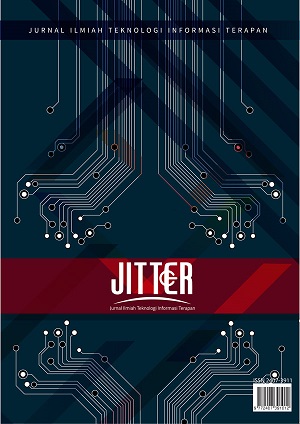Penggunaan Virtual lab. Circuit Wizard Untuk Simulasi Rangkaian High Pass Filter Pasif
DOI:
https://doi.org/10.33197/jitter.vol9.iss2.2023.1010Keywords:
High Pass Filter, Filter Pasif, Circuit WizardAbstract
Passive High Pass Filter will be discussed in this paper; the filter itself is a circuit that determines the amount of a certain frequency to be streamed and will reject frequencies that are not suitable. Meanwhile, a passive filter is an electrical circuit that can block intervals at certain signal frequencies to filter incoming signals. The benefit of passive filters is that they can be used at higher frequencies because their dimensions are larger than active filters. Measurement of the voltage gain in the Passive High Pass Filter circuit using laboratory methods using a simulation approach with the Circuit Wizard simulator or directly. The research method consists of two experimental scenarios that aim to compare the signals generated from stage I to stage V. For the scenario I, the simulation is carried out using the Circuit Wizard simulator. The capacitor is one of the reactive components that will offer a variety of resistance to different frequency signals based on a High Pass RC Filter circuit with a capacitor that has a high value of resistance to low frequencies or resistance to high-frequency transmissions will be minimal. The capacitor feature makes it resistant to low-frequency or DC signals, so only high-frequency signals can travel through the capacitor and block the path of low-frequency impulses. The high pass filter can attenuate or maintain low frequencies below the cut-off frequency while passing high signal frequencies or passing signals above them.
Downloads
Downloads
Published
How to Cite
Issue
Section
License
Copyright (c) 2023 Syifaul Fuada, Gita Alisrobia, Muntaha Hasanah, Meiliya Cahya Yustina, Dina Rahmawati

This work is licensed under a Creative Commons Attribution-NonCommercial-ShareAlike 4.0 International License.
Submission of a manuscript implies that the submitted work has not been published before (except as part of a thesis or report, or abstract); that it is not under consideration for publication elsewhere; that its publication has been approved by all co-authors. If and when the manuscript is accepted for publication, the author(s) still hold the copyright and retain publishing rights without restrictions. Authors or others are allowed to multiply the article as long as not for commercial purposes. For the new invention, authors are suggested to manage its patent before published. The license type is CC-BY-SA 4.0.




.png)
.png)













.png)


